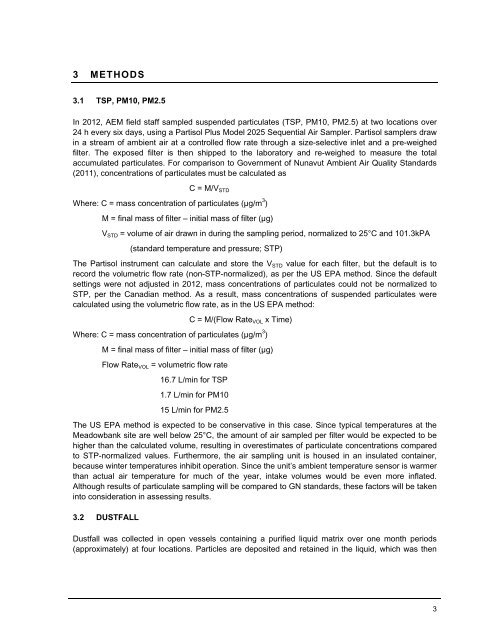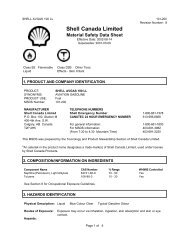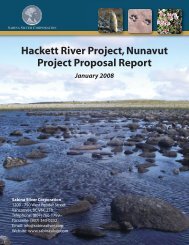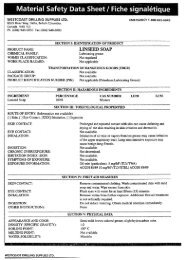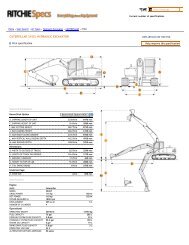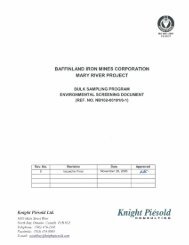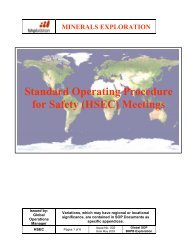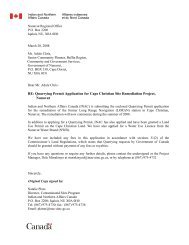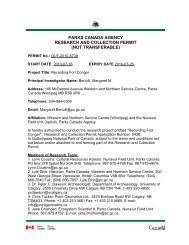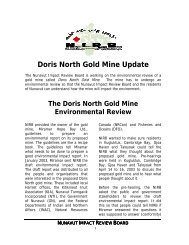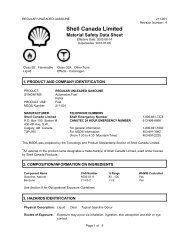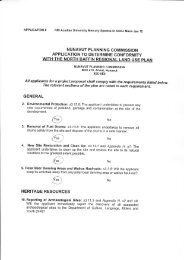130419-03MN107-App G7 Air Monitoring-IA2E.pdf - NIRB
130419-03MN107-App G7 Air Monitoring-IA2E.pdf - NIRB
130419-03MN107-App G7 Air Monitoring-IA2E.pdf - NIRB
You also want an ePaper? Increase the reach of your titles
YUMPU automatically turns print PDFs into web optimized ePapers that Google loves.
3 METHODS3.1 TSP, PM10, PM2.5In 2012, AEM field staff sampled suspended particulates (TSP, PM10, PM2.5) at two locations over24 h every six days, using a Partisol Plus Model 2025 Sequential <strong>Air</strong> Sampler. Partisol samplers drawin a stream of ambient air at a controlled flow rate through a size-selective inlet and a pre-weighedfilter. The exposed filter is then shipped to the laboratory and re-weighed to measure the totalaccumulated particulates. For comparison to Government of Nunavut Ambient <strong>Air</strong> Quality Standards(2011), concentrations of particulates must be calculated asC = M/V STDWhere: C = mass concentration of particulates (µg/m 3 )M = final mass of filter – initial mass of filter (µg)V STD = volume of air drawn in during the sampling period, normalized to 25°C and 101.3kPA(standard temperature and pressure; STP)The Partisol instrument can calculate and store the V STD value for each filter, but the default is torecord the volumetric flow rate (non-STP-normalized), as per the US EPA method. Since the defaultsettings were not adjusted in 2012, mass concentrations of particulates could not be normalized toSTP, per the Canadian method. As a result, mass concentrations of suspended particulates werecalculated using the volumetric flow rate, as in the US EPA method:C = M/(Flow Rate VOL x Time)Where: C = mass concentration of particulates (µg/m 3 )M = final mass of filter – initial mass of filter (µg)Flow Rate VOL = volumetric flow rate16.7 L/min for TSP1.7 L/min for PM1015 L/min for PM2.5The US EPA method is expected to be conservative in this case. Since typical temperatures at theMeadowbank site are well below 25°C, the amount of air sampled per filter would be expected to behigher than the calculated volume, resulting in overestimates of particulate concentrations comparedto STP-normalized values. Furthermore, the air sampling unit is housed in an insulated container,because winter temperatures inhibit operation. Since the unit’s ambient temperature sensor is warmerthan actual air temperature for much of the year, intake volumes would be even more inflated.Although results of particulate sampling will be compared to GN standards, these factors will be takeninto consideration in assessing results.3.2 DUSTFALLDustfall was collected in open vessels containing a purified liquid matrix over one month periods(approximately) at four locations. Particles are deposited and retained in the liquid, which was then3


